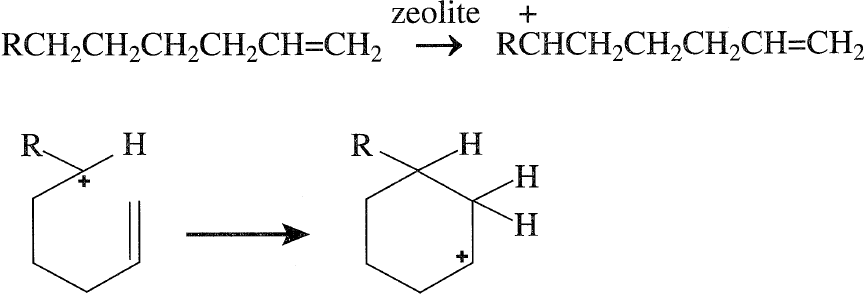


 علم الكيمياء
علم الكيمياء 
 الكيمياء التحليلية
الكيمياء التحليلية 
 الكيمياء الحياتية
الكيمياء الحياتية 
 الكيمياء العضوية
الكيمياء العضوية 
 الكيمياء الفيزيائية
الكيمياء الفيزيائية
 الكيمياء اللاعضوية
الكيمياء اللاعضوية 
 مواضيع اخرى في الكيمياء
مواضيع اخرى في الكيمياء
 الكيمياء الصناعية
الكيمياء الصناعية |
Read More
Date: 31-8-2017
Date: 8-8-2017
Date: 31-8-2017
|
Cracking Reactions
Amajor difference between thermal and catalytic cracking is that reactions through catalytic cracking occur via carbocation intermediate, compared to the free radical intermediate in thermal cracking. Carbocations are longer lived and accordingly more selective than free radicals. Acid catalysts such as amorphous silica-alumina and crystalline zeolites promote the formation of carbocations. The following illustrates the different ways by which carbocations may be generated in the reactor: Crude Oil Processing and Production of Hydrocarbon Intermediates

2. Reaction between a Bronsted acid site (H+) and an olefin

3. Reaction of a carbonium ion formed from step 1 or 2 with another. hydrocarbon by abstraction of a hydride ion.

Abstraction of a hydride ion from a tertiary carbon is easier than from a secondary, which is easier than from a primary position. The formed carbocation can rearrange through a methide-hydride shift similar to what has been explained in catalytic reforming. This isomerization reaction is responsible for a high ratio of branched isomers in the products.
The most important cracking reaction, however, is the carbon-carbon beta bond scission. A bond at a position beta to the positively-charged carbon breaks heterolytically, yielding an olefin and another carbocation. This can be represented by the following example:

The new carbocation may experience another beta scission, rearrange to a more stable carbonium ion, or react with a hydrocarbon molecule in the mixture and produce a paraffin. The carbon-carbon beta scission may occur on either side of the carbocation, with the smallest fragment usually containing at least three carbon atoms. For example, cracking a secondary carbocation formed from a long chain paraffin could be represented as follows:

If R = H in the above example, then according to the beta scission rule (an empirical rule) only route b becomes possible, and propylene would be a product:

An isopropyl carbocation cannot experience a beta fission (no C-C bond beta to the carbon with the positive charge).25 It may either abstract a hydride ion from another hydrocarbon, yielding propane, or revert back to propene by eliminating a proton. This could explain the relatively higher yield of propene from catalytic cracking units than from thermal cracking units.
Aromatization of paraffins can occur through a dehydrocyclization reaction. Olefinic compounds formed by the beta scission can form a carbocation intermediate with the configuration conducive to cyclization. For example, if a carbocation such as that shown below is formed (by any of the methods mentioned earlier), cyclization is likely to occur.

Once cyclization has occurred, the formed carbocation can lose a proton, and a cyclohexene derivative is obtained. This reaction is aided by the presence of an olefin in the vicinity (R–CH=CH2).

The next step is the abstraction of a hydride ion by a Lewis acid site from the zeolite surface to form the more stable allylic carbocation. This is again followed by a proton elimination to form a cyclohexadiene intermediate. The same sequence is followed until the ring is completely aromatized.

During the cracking process, fragmentation of complex polynuclear cyclic compounds may occur, leading to formation of simple cycloparaffins. These compounds can be a source of C6, C7, and C8 aromatics through isomerization and hydrogen transfer reactions.
Coke formed on the catalyst surface is thought to be due to polycondensation of aromatic nuclei. The reaction can also occur through a carbonium ion intermediate of the benzene ring. The polynuclear aromatic structure has a high C/H ratio.



|
|
|
|
"إنقاص الوزن".. مشروب تقليدي قد يتفوق على حقن "أوزيمبيك"
|
|
|
|
|
|
|
الصين تحقق اختراقا بطائرة مسيرة مزودة بالذكاء الاصطناعي
|
|
|
|
|
|
|
قسم شؤون المعارف ووفد من جامعة البصرة يبحثان سبل تعزيز التعاون المشترك
|
|
|